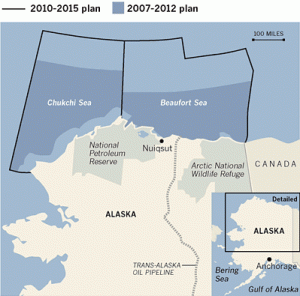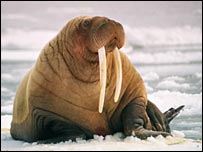The Arctic supposedly holds 90 billion barrels of oil – 22% of the world’s remaining oil and gas reserves. These ample supplies make the region highly desirable to the oil and gas industry. Under the Bush Administration, the Department of the Interior auctioned off leases for offshore drilling in the Outer Continental Shelf to take place during a five-year leasing program from 2007 to 2012. Most of the new drilling rights were for areas in the Beaufort, Bering, and Chuchki Seas off Alaska. Although the price of a barrel of oil has dropped from its high of $147 last July, Shell Oil predicts that demand for oil will double by 2050 – making the leases potentially very valuable. The highest bid for a lease was over 105 million dollars, by Shell Gulf of Mexico.

Map of Proposed OCS Drilling in Alaska. © Minerals Management Service, from LA Times.
But last week, the U.S. Court of Appeals in Washington, D.C. ruled that the leases were sold without proper environmental review, and consequently halted the program pending further consideration. The decision cancels the proposed drilling plan from 2007-2012, and makes the plan from 2007-2015 subject to greater environmental scrutiny.
The Center for Biological Diversity filed the suit against the Department of the Interior, with four main arguments:
The Court of Appeals dismissed the claims regarding NEPA, claiming that they were not yet “ripe for review.” The panel also found claims regarding climate change and environmental baselines unjustifiable. However, the court, in the opinion written by Chief Judge David B. Sentelle, found “meritorious [the] Petitioners’ challenge to the Leasing Program on grounds that the Program’s environmental sensitivity rankings are irrational.”
The court ruled that reliance on NOAA data was “irrational” because although the OSCLA makes it clear that an agency “must assess the environmental sensitivity of “different areas of the outer Continental Shelf” in order to make its determination of when and where to explore and develop additional areas for oil,” the Department of the Interior assessed “only the effects of oil spills on shorelines” and provided “no explanation for how the environmental sensitivity of coastal shoreline areas can serve as a substitute for the environmental sensitivity of OCS areas, when the coastline and proposed leasing areas are so distant from each other.” Thus, the leases are in clear violation of the OSCLA.

Pacific Walrus. © BBC.
In total, there were four petitioners, comprising three NGOs and an Alaska tribal group. The Center for Biological Diversity, the Alaska Wildnerness League, and Pacific Environment are non-profit organizations aiming to protect the coastal regions of Alaska, which are home to species like polar bears, right whales, the Pacific walrus, and seabirds. The fourth petitioner, the Native Village of Hope, Alaska, is a federally recognized tribal government. The village uses the waters off Alaska for subsistence and cultural activities, such as whaling, fishing, and hunting.
Both environmental NGOs and indigenous tribes believe that it is foolhardy to drill in the sensitive waters until more is known about its effect on the environment. Offshore oil drilling is more controversial than onshore oil drilling because oil rigs are unsightly and oil spills could cause much more harm to the sensitive marine environment. Memories of the Exxon Valdez still haunt many Alaskans. Doreen Lampe, a resident of the whaling town of Barrow, Alaska, was quoted in the Los Angeles Times after hearing the news of the ruling. She remarked, “That’s great news. We’ve been requesting a moratorium until more research is done…I truly hope they will do a better job of studying this.”
On the other side of the issue, the American Petroleum Institute issued a press release in which they stated, “It would be a disservice to all Americans — and a devastating blow to the economy — if this decision were to delay further the development of vital oil and natural gas resources.”

Secretary of the Interior Ken Salazar. © DoI.
The Obama Administration is not wholly opposed to offshore drilling, yet it is giving environmental concerns more attention than former President Bush. Secretary of the Interior Ken Salazar just completed a tour of four regional hearings, where he listened to the public’s concerns about energy and the environment. The tour went through the Gulf Coast, the Pacific Coast, the Alaska Coast, and the Atlantic. With the meetings, Salazar said, “The additional time we are providing will give states, stakeholders, and affected communities the opportunity to provide input on the future of our offshore areas.”
A spokesman for the Department of the Interior, Kendra Barkoff, said, “Secretary Salazar believes that we need a comprehensive approach to an offshore energy plan, based on sound information about our resources and extensive public input.”
In addition, on Monday, Salazar recently announced that in the next two years the coastal states will share $500 million from revenues from the OCS to restore and protect their coastal environments, such as wetlands and wildlife habitats.
News links:
Drilling off Alaska can’t proceed without further environmental review (LA Times)
Battle over offshore drilling in Arctic dwarfs ANWR (NPR)